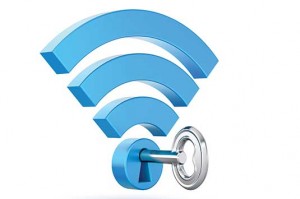Most homes with Internet access also have Wi-Fi routers that send movies, TV shows, music and other data to every corner of our living space — and sometimes beyond its walls. After all, it’s data sent through the air, and with the right tools, anyone could tap that stream of data.
Even if it’s as innocuous as piggybacking your Wi-Fi to browse, stream movies or download music, though, unsecured Wi-Fi can have a dramatic effect on the speed of your connection. It can slow it down and cause needless frustration. But that’s the best-case scenario. All it takes is nefarious know-how, and your computers can be hijacked from the outside via Wi-Fi.
That’s why it’s especially important to lock down Wi-Fi for company business purposes. Company files, personal info, passwords and online accounts are easily compromised if weak, or worse, no obstacles stand between your Wi-Fi and everyone else within the radius of its signal.
Typically, your Internet service provider (ISP) sets up Wi-Fi that’s already encrypted, which is good. But often the type of encryption used by the big providers, such as cable companies, is out of date — at least from an outside saboteur’s point of view. There are several types of encryption, and knowing the difference can help you decide what will work best for your company. For example, Wired Equivalent Privacy (WEP) can be cracked with considerable ease, and is often a service provider’s default; it really only protects you from casual Wi-Fi users. Explore your options by consulting an expert.
Wi-Fi on the road
The flipside of Wi-Fi security pertains to wireless technology in the field. When you or your employees are required to access Wi-Fi outside of company networks, there are numerous pitfalls that must be avoided to keep your mobile devices safe.
Your first line of defense is your mobile device. To operate safely in a Wi-Fi world, it’s imperative to make sure all of your updates are current. In addition to fixing bugs and improving your device’s functionality, updates often contain important security upgrades that specifically address Wi-Fi safety.
But updates don’t ensure protection. Investing in antivirus/antimalware software is essential. You’ve no doubt done this for your personal computer, but a mobile device without security software is equally susceptible to invasion. The good news: If you like the security software used on your computers, the same company that supplied it is likely to offer mobile security options as well.
If you’re using Wi-Fi outside of your office, and the noncompany system you’re using has no verification sign-in, avoid accessing it if possible. Mobile hotspots and open networks that allow you to access a network without a password can be particularly dangerous. Unprotected networks are easy targets for hackers, and can compromise practically all the data on your device. Also, simply turning off the Wi-Fi or hotspot transmitter settings on your mobile device when in an unfamiliar setting can add another layer of protection.
If you must use Wi-Fi in the field — for example, using a hotspot — you can use a virtual private network (VPN) connection to secure your Internet traffic by redirecting it to the VPN server via an encrypted tunnel. This ensures local eavesdroppers, who might also be in range of the hotspot, won’t see your Internet traffic.
This only scratches the surface of Wi-Fi safety. If you’re the least bit insecure about the security of your Wi-Fi, talk to your Internet provider about your best options. Don’t, however, allow them to sell you on unnecessary options. Do your homework first, so you ask the right questions with more proficiency than most customers they’re used to dealing with.

Leave A Comment